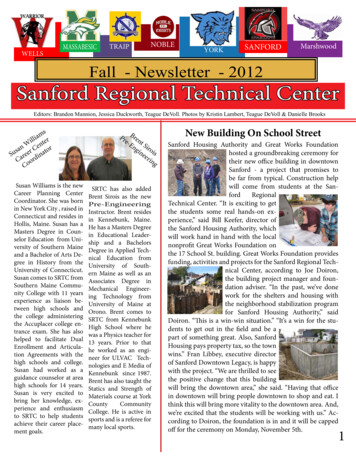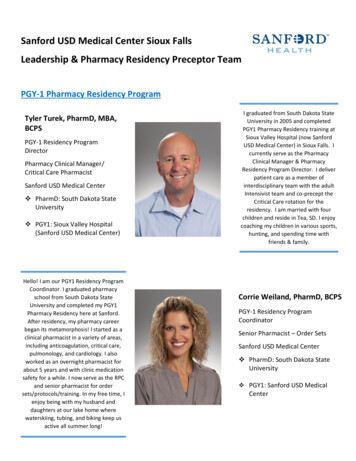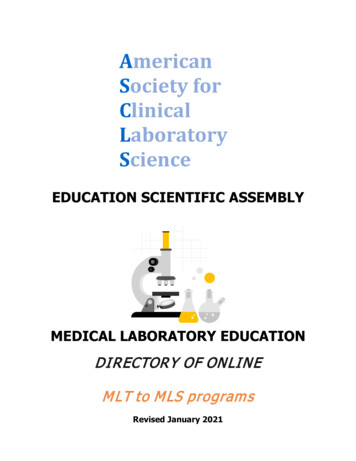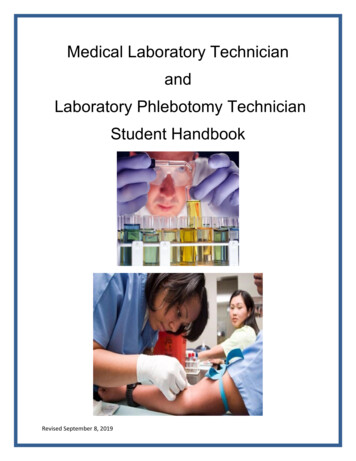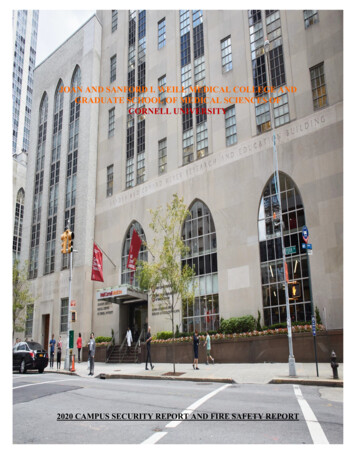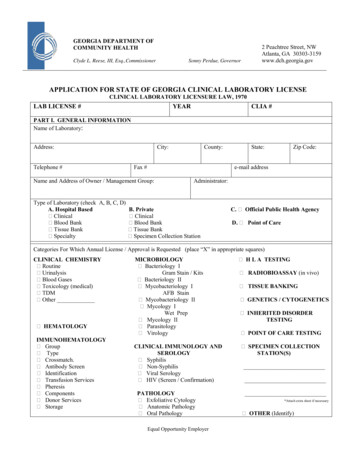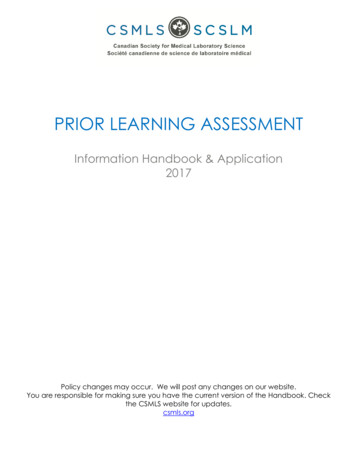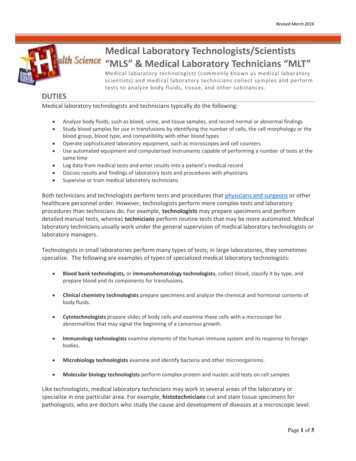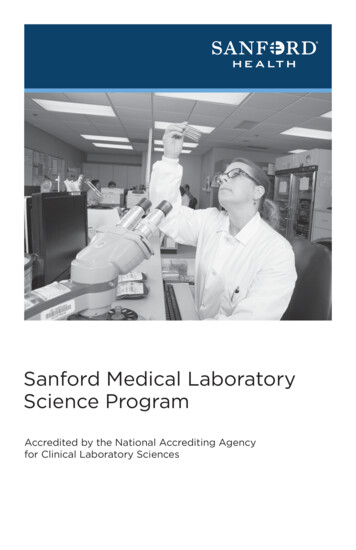
Transcription
Sanford Medical LaboratoryScience ProgramAccredited by the National Accrediting Agencyfor Clinical Laboratory Sciences
Mission StatementThe Sanford Medical Laboratory Science Program is committed to providing didacticand practical instruction which will allow our students to acquire the knowledge, skillsand attitudes necessary to attain a high level of competency in the practice of medicallaboratory science.The Medical Laboratory Science Program is one of the educational programs atSanford USD Medical Center. It is accredited by the National Accrediting Agency forClinical Laboratory Sciences.The majority of students enrolled in the program are college seniors on affiliationfrom their respective colleges to complete the requirements for the ClinicalLaboratory/Medical Laboratory Science degree. Other students are those who haveobtained a baccalaureate degree prior to entry. All accepted students will be subject toa background check.Graduates of this program, with baccalaureate degrees requirements met, are eligibleto take the American Society for Clinical Pathology (ASCP) Board of Certificationexam, or an equivalent certification exam. Granting of the program certificate is notcontingent upon the student passing any type of external certification or licensureexam. However, becoming certified is highly recommended and often required bymedical facilities.About Sanford HealthSanford Health, one of the largest health systems in the United States, is dedicated tothe integrated delivery of health care, genomic medicine, senior care and services,global clinics, research and affordable insurance. Headquartered in Sioux Falls,South Dakota, the organization includes 46 hospitals, 1,525 physicians and morethan 200 Good Samaritan Society senior care locations in 26 states and 10 countries.Sanford Health includes: 46 medical centers224 clinic locations233 senior living communities158 skilled nursing and rehab facilities42 affordable housing locations216,000 Sanford Health Plan members47,757 employees1,525 physicians, 1,214 advancedpractice providers and 8,716 registerednurses delivering care in more than 80specialty areas1
About Sanford HealthOur MissionDedicated to sharing God’s love through the work of health, healing and comfort.Our VisionImproving the human condition at every stage of life through exceptional care,spiritual enrichment, innovation and discovery.Our ValuesCalling – Demonstrating enthusiasm for those we serve, our vocation and theorganization’s mission.Courage – Having strength to persevere, innovate, use our voices and take action.Family – Celebrating the connection and commitment we have to each otherthrough it all.Community – Providing care in a diverse range of settings and environments with afocus on the wellness of individuals.Service – Sharing God’s love through actions that reflect compassion, acceptance,love, humility and sincerity in keeping with the common Lutheran heritage of bothorganizations.Resolve – Adhering to systems that align actions to excellence,efficiency and purpose.Advancement – The pursuit of individual and organizational growthand development.Sanford Health promise to patients and employeesDeliver a flawless experience that inspires.Sanford Health CultureAt Sanford Health, we believe quality health care should be available close to homefor everyone, everywhere.From our roots in the Midwest, we are proud to set the standard for deliveringworld-class care. By building on the talents, experiences and beliefs of our employees,we aim to improve the lives of patients and residents throughout the diversecommunities we serve. Through our shared commitment we can become the nation’smost connected, widest-reaching health care system, shrinking the distance betweenevery patient and their best, healthiest life.2
The Clinical LaboratoryThe Laboratory is located on the 1000 level of the West Patient Building onthe Sanford USD Medical Center campus. It covers an area of approximately 17,200square feet, and includes both clinical and anatomic laboratory departments,processing rooms for the Blood Bank, and a classroom which is utilized for didacticinstruction. Pathology services are provided by the Sanford Pathology Departmentand the Sanford School of Medicine Pathology Residency Program, located adjacentto the laboratory.The Laboratory is equipped with state-of-the-art instrumentation, which allows ourlaboratory personnel to perform a wide variety of high-complexity tests accurately,precisely, and on a timely basis. Areas of testing include chemistry, hematology,coagulation, flow cytometry, urinalysis, immunology, immunohematology, andhistology. Microbiology testing is performed off campus at a separate Sanfordinfectious diseases laboratory located within Sioux Falls.Laboratory AdministrationMedical DirectorKim Bohy, MD, Sanford PathologyLaboratory Administrative DirectorTaryn Smith, BS, MLS (ASCP) CMDepartment SupervisorsAdrian Holzer, BS, MLS (ASCP) CMLindsay Fricke, MBA, MLS (ASCP) CMRichard Krum, HT (ASCP)Becky Carter, PBT (ASCP)Kim Bennett, BS, MLS (ASCP) CM3
Program AdministrationMedical DirectorMichael C. Geis, MD, Sanford PathologyProgram DirectorMeredith Loosbrock, MSA, MLS (ASCP) CMProgram FacultyMeredith Loosbrock, MSA, MLS (ASCP) CMLacey Hewitt, BS, MT (ASCP)Alycia Green, BS, MLS (ASCP) CMAustin Haack, BS, MLS (ASCP) CMStephanie Major, BS, MLS (ASCP) CMAdjunct Faculty: Pathology Department and clinical staff specialistsAdvisors and AffiliatesMark Larson, PhD, Augustana UniversityKari Potter, MS, MLS (ASCP)CM, University of South DakotaJessica Ness, Academic Advisor, Northern State UniversityZachary Varpness, PhD, Northwestern CollegeBrian Lowery, MS, University of Sioux FallsChun Wu, PhD, Mount Marty UniversityTony Greenfield, PhD or Vaughn Gehle, PhD, Southwest Minnesota State UniversityLois Anderson, MA, MT (ASCP), Minnesota State University Mankato4
Entrance RequirementsPrerequisite CreditsThe applicant must either be a college graduate or be enrolled in an affiliated“3 plus 1” program which grants credit for the work completed during the clinicalprogram year at the hospital.Prior to entering the program, the student must have completed all pre-clinical courserequirements at his/her college or university. The “3 plus 1” student must be eligiblefor a baccalaureate degree upon satisfactory completion of the clinical program.The minimal pre-clinical course and credit requirements are:* 16 semester hours of chemistry. This includes organic and/or biological chemistry.16 semester hours of biological sciences to include anatomy andphysiology, microbiology with a lab, immunology (2 creditmin.), as well as genetics and/or molecular biology is required.One course of college level mathematics, and statistics.* The chemistry and biological science courses must be acceptable toward a major inthose fields or in medical laboratory science, or be certified by the college/university as equivalent.Survey courses do not qualify as fulfillment of the prerequisites. Remedial mathematics courses willnot satisfy the mathematics requirement. Required classes must be completed with a letter grade of Cor higher.Non-US student applicants without a BS/BA degree must be enrolled in an affiliatedcollege, and have a minimum of 24 semester hours or credits of undergraduatecoursework completed within the US at the time of application. Non-US applicantswith a BS/BA degree completed outside the US, and with all prerequisite courseworkcompleted, will be required to have a minimum of 8 semester hours or credits ofrelevant science coursework completed in the US at the time of application. Studentswith foreign degrees must have their transcripts evaluated by an appropriate US agency.All students with English as their second language must successfully completethe TOEFL exam. Each non-US applicant must possess the appropriate VISA anddocumentation allowing them to complete the clinical program. Sanford MLS programdoes not provide VISA sponsorship.5
Other recommended courses are:Computer SciencePhysicsAcademic and Technical RequirementsApplicants must have a minimum cumulative and scientific grade point average(GPA) of 2.80 (on a scale of 0-4.0). Applicants with GPA's below 2.80 may submit anapplication, however they will be evaluated and considered only after candidates withGPA's of 2.80 or higher have been processed.For acceptance, the applicant must have sufficient visual, motor and intellectualfunction to correctly identify microscopic cellular structure; operate instruments andread printouts; enter computer data accurately; calculate, evaluate and explainlaboratory results and quality control statistics; and obtain and handle specimenssafely. The successful applicant must also have the ability to function effectivelyin stressful situations, and interact and communicate positively with patients andother healthcare professionals. A detailed description of these essential requirements(standards) is available on the website and from the Program Director. It is providedso that potential applicants can independently evaluate their ability to fulfill theexpected requirements of a clinical laboratory scientist/medical technologist.It is required that all applicants read and sign the form providing this description atthe time of application.ApplicationApplication ProcedureApplication information may be obtained from our website, ties. Applications are accepted August 1 to October1 for the class starting the following July. Interviews are completed during October/November and student selection is usually completed by late December.6
Application EvaluationThe evaluation of an applicant is based upon the GPAs, interview(s), references,and a statement of the applicant’s expectations and goals. These are scored andcarry the following weight-values:20%20%10%30%15%5%Accepted students must continue to maintain a grade of "C" or higher in all requiredcoursework. Additional considerations include: criminal background check, ties toSanford Health, ties to the community or surrounding area, and US residency status.Advanced PlacementApplicants with previous clinical laboratory experience, such as MLTs, will beevaluated on an individual basis regarding a reduced clinical rotation schedule onceaccepted into the program. This will require proof of competency in the areasof reduced clinical time to the satisfaction of the Faculty and the MLS ProgramDirector. Applicants will need to have completed a BS/BA degree and meet allprerequisite requirements by the program start date. Any exception will be at thediscretion of the MLS Program Director, and with clinical instructor(s) consultation.The didactic portion of the program does not allow for advanced placement.7
Progress RequirementDuring the clinical year, students must maintain a minimal grade of C.For graduation, a student must have that grade, or better, in each of the subjects.The grading system is based upon the student’s attaining minimum competencyfor career entry.MLS Program Grading ScaleA 93-100%or4.00 quality pointsA90-92%or3.67B 87-89%or3.33B 83-86%or3.00B80-82%or2.67C 77-79%or2.33C 73-76%or2.00C70-72%or1.67Failing 70%Transcript grades are calculated by the following breakdown (excluding Mgmt):40% Final Bench Grade 50% Final Didactic Grade 10% Final Comprehensive ExamGrading in the didactic portion of the program is based upon written examinations,assignments, or research paper. The didactive grade average in each subject is utilized inthe calculation of final grades. Progress in the practical portion (bench performance) ofthe program is evaluated after each rotation through a department. The grade receivedon the final rotation through each department is utilized in the calculation of finalgrades. No credit is given for partial completion of the course.Causes for Dismissal or ProbationOn the Basis of Grades: A policy on academic status is in place and will be distributed to allincoming students. Failure of more than 2 exams could result in dismissalfrom the program.Grade evaluations are made periodically throughout the program year.Students not maintaining the minimal allowed average are placed onacademic probation. Not maintaining an average grade of "C" by the twoweek break could result in dismissal from the program.Progress records are maintained throughout the year and are available to thestudent at any time.8
On the Basis of Conduct: Theft, immoral conduct, fighting, willful destruction of property on hospitalgrounds. Use or being under the influence of alcohol or illegal drugs withinthe institution. Cheating on school examinations or dishonesty in the performance orreporting of the procedures within the laboratory. Inconsiderate treatment of patients or discussion of confidential informationwith unauthorized persons. Excessive unexcused absenteeism and/or tardiness. Any other act classified as criminal. Unwillingness or inability to meet the "essential requirements"of the programStudents dismissed for reasons of either grades or conduct will not be allowedreentry into the program.Appeals ProcedureAn appeals procedure is available for use by any student having a grievance basedupon seemingly unfair treatment. According to the procedure, a grievance not settledbetween the parties immediately involved may be appealed to the Program Director ofthe school, then to the Medical Director of the school and, finally, to the ExecutiveDirector over Laboratory Services.Expenses Deposit 8300, inclusive of books.Tuition is due in full by the program start date. Students are required toprovide their own personal laptop to use during the clinical year. The purchase andupkeep of this laptop is the financial responsibility of the student and is not included intuition costs. 300 (Non-refundable and applicable to tuition)Lab Coat Water resistant lab coats worn while working in clinical testing areasare provided by Sanford USD Medical CenterRoomsMealsStudents are responsible for their own living quartersAvailable at moderate cost in the hospital cafeteriaTransportation Students are required to have a valid driver's license as well asreliable personal transportation for travel to and from Sanford USDMedical center and outreach locations. These are the student'sfinancial responsibility.9
RefundsStudents who withdraw from the program will be allowed a tuition refund basedupon the following schedule:First Week 80% less depositSecond Week60% less depositThird Week 40% less depositFourth Week 20% less depositNo Refund ThereafterNote: No Credit will be granted for partial completionof the program.Financial AidScholarships and LoansStudents who will be attending the Sanford MLS Program on affiliation from one ofthe programs affiliated colleges/university will work with their home school’sFinancial Aid department to determine their aid package. This may include acombination of scholarships, federal loans and grants, and private loans.Important Note: For those students attending our program independently and withBS/BA degrees already completed, federal financial aid is currently not available forthe Sanford MLS program. These students will need to seek private funding to meettuition and living expense needs. In addition, federal loan deferments may or maynot be allowed during the program year. Throughout the program year, variousscholarship opportunities arise through Sanford, professional societies, and medicalcorporations that students may qualify to apply for.Part-Time WorkSometimes Phlebotomy, Microbiology assistant, or POC positions are available.Hourly rates of compensation are available when and if these positions are available.Outside work involving more than a minimal number of hours per week is stronglydiscouraged.10
Health Requirements and ServicesPrior to the start of the clinical program, students will be required to provide proof ofimmunization for: MMR (measles/mumps/rubella), Varicella (chicken pox),Tuberculosis (TB), Hepatitis B, COVID, and seasonal Influenza; sis) is recommended but not requiredat this time. A health assessment and drug screen may both or individually berequired. More information regarding immunizations and health assessment will besent to accepted students about 2 months prior to the program start date. Costresponsibility should be presumed to be the student’s responsibility.o Biohazard ExposureThe medical laboratory science program utilizes actual patient specimens fromthe clinical laboratory for learning opportunities and labs. During orientationstudents are instructed on safety in the lab and handling of potentially infectiousspecimens. Since the potential hazards are unknown, all specimens should betreated as if they were potentially infectious. Students are under the directsupervision by the clinical instructor or responsible technical staff member in theclinical laboratory. Appropriate personal protective equipment and work practicecontrols must be utilized at all times.If any illness, injury, or exposure occurs during program hours, students will bedirected to the appropriate department or facility for treatment. The student isresponsible for health care costs and insurance coverage.Program CalendarThe Program spans from July to May. The weekly schedule follows a Monday throughFriday pattern. Students are allowed five days or 40 hours of personal time for illness orpersonal need. Additional time missed, or time missed during a shorten rotation, mustbe made up. There is a two-week break falling over Christmas. In addition, there is ashort fall break, typically in early October. Exact program dates and timeline changewith each program year and will be provided to accepted students. Recognized holidaysfollow the hospital holiday schedule and include: July 4th, Labor Day, Thanksgiving,Christmas Day, New Year's Day and Memorial Day. The Program also allows the Fridayafter Thanksgiving off unless a student needs to make up missed time. Time off aroundEaster is provided when the schedule allows.11
The Program consists of didactic classroom lectures, bench instruction and clinicaltesting in each department, student laboratory sessions and some independent study.Hours are approximately from 7 a.m.-4 p.m. Monday through Thursday. Hourson Friday are from 7 a.m.-approximately noon. Three hours of didactic lecture arescheduled between 1 and 4 p.m. Monday through Thursday. Some bench areas mayrequire students to come in earlier than 7 a.m. Other rotations may require benchinstruction to take place in the evening hours. Students are provided with a weeklyrotation schedule for the entire program year during orientation week. There aremultiple rotations through each of the four major departments: Hematology,Chemistry, Microbiology, Blood Bank, as well as enrichment rotations. There areusually two or three students assigned to each department at a time. Bench instructorsoversee the bench instruction in their respective departments, but students will alsowork with other staff members at times.General Program Affective Objectives/Expected Behaviors:In both the classroom and clinical setting, the Medical Laboratory Science studentwill:1. Display emotional stability, remain calm, and exercise good judgment understressful situations.2. Communicate effectively, both orally and in writing, with patients, visitors, fellowstudents, instructors, and staff. This includes relaying and receiving information.3. Work productively and efficiently, both independently and in a team environment.Utilize time management and organizational skills for maximum benefit.4. Demonstrate honesty, integrity, and empathy with patients, visitors, fellowstudents, instructors, and staff.5. Behave in an ethical manner by following all established rules, policies, andprocedures; taking ownership of errors and responsibility for his/her actions.6. Project a professional image in dress and demeanor.7. Maintain a positive and professional attitude, even under difficult circumstances.8. Remain flexible and adaptive to change.9. Take ownership for his/her learning, by completing assignments as directed and bycoming prepared for class and clinical bench rotation each day.10. Demonstrate and promote pride in the Medical Laboratory Science profession.12
Program Goals1. Provide a Medical Laboratory Science Program that meets or exceeds thestandards developed by the National Accrediting Agency for Clinical LaboratoryScience (NAACLS)2. Maintain affiliations with regional colleges and universities by providing acurriculum that allows students to complete their bachelor degree in the field ofMedical Laboratory Science3. To provide students with the clinical education and professional development tosucceed in the field of laboratory science, complete certification, and provide afoundation for healthcare career advancement4. Provide high quality, well prepared graduates to help meet staffing needs locally,regionally, and at the national levelValuesProgram faculty is encouraged to serve as positive, ethical role models for ourstudents, and to be a constant source of encouragement and motivation. The valuesfaculty strive to instill are: Respect: for patient, colleague, team, and selfAccountability: for our actions, attitudes, and wordsIntegrity: honesty, ethics, and adherence to policyTrust: support one another individually and as a teamExcellence: strive to be the best in quality, efficiency, and costPassion: enthusiasm for the work and the patient's overall experienceAdvancement: the pursuit of continued personal and organization growthCompetenciesAt career entry, graduates will be able to demonstrate following competencies:Professional Skills and Knowledge Perform phlebotomy procedures with skill and according to proper protocol Perform analytical laboratory tests from low to high complexity with skill,accuracy, and timeliness following Standard Operating Procedures (SOPs) Conduct routine instrumentation maintenance following SOP13
Analyze and review quality controls employing quality assurance principlesand practices to ensure the accuracy of test results Perform, evaluate, and improve pre-analytical, analytical, and post-analyticalprocedures for optimum quality of laboratory results Troubleshoot quality control issues, sample integrity problems, andinstrumentation issues utilizing a combination of critical thinking,maintenance procedures, and continuous quality improvement guidelines Review patient results for acceptability, follow-up action, or additional testingas indicated Utilize information technology to perform and report results, accessinformation, analyze data, and communicate with members of thehealth care team Comply with all regulatory requirements and policies of the facility Explain the significance of various laboratory tests in the diagnosis andtreatment of disease, as well as, preservation of health Employ, with guidance, knowledge of method and instrument selectionevaluation practices to determine implementation of new procedures andacquisition of new instrumentation, or investment in information technology,with consideration of budget, space, and staff Utilize education terminology and techniques to train/educate usersand providers of laboratory services Management skills in basic financial management, human resourcesmanagement, regulation and policy, safety and supervisionProfessional Attributes Maintains a positive attitude and emotional stability under pressure Adapts to changing workflows, the dynamics of the healthcare field, and theneeds of the laboratory customer Works productively, efficiently, and accurately; both independently and as ateam member Communicates effectively and professionally with colleagues, team, visitors,and patients Consistently performs in an honest, ethical, and professional manner Strives to grow as a professional through continuing education andprofessional involvement14
Course DescriptionsClinical Microscopy/Urinalysis,2 semester hoursLecture, supervised laboratory instruction, quality control, instrumentation,computer applications and experience in body fluids and urine in regard to chemicaland cellular composition. Anatomy and physiology, theory of renal function in healthand disease.Clinical Hematology/Coagulation,8 semester hoursLecture, supervised laboratory instruction, quality control, instrumentation,computer application and experience in the analysis of cellular elements of the bloodand bone marrow, both normal and abnormal, and the hemostatic mechanisms ofthe blood.Clinical Microbiology,10 semester hoursLecture, supervised laboratory instruction, quality control, instrumentation, computerapplications and experience in the isolation and identification of pathogenicorganisms and their susceptibility to antimicrobial agents. Includes bacteriology,mycology, parasitology, and virology.Clinical Serology/Immunology,2 semester hoursLecture on antigen/antibody structure-function-interactions, supervised laboratoryinstruction, quality control, instrumentation, computer applications and experience inapplying the principles of immunology to serologic diagnosis.Clinical Chemistry/Immunoassay/Body Fluids,11 semester hoursLecture, supervised laboratory instruction, quality control, computer applications,instrumentation and experience in medically oriented biochemistry as applied tonormal and abnormal physiology and analyses of body constituents. This course alsoincludes analysis of special body fluids such as amniotic, synovial, cerebrospinal andpleural fluids.15
Clinical Immunohematology, 6 semester hoursLecture, supervised laboratory instruction, quality control, instrumentation,computer applications and experience in theory and practice ofimmunohematology as applied to blood transfusion, component theory,autoimmune diseases, immunologic diagnostic procedures and blood componentpreparation and administration.Management and Supervision, 1 semester hourLectures and/or seminars on theory and techniques of laboratory orientedmanagement practices utilized in planning, organizing, directing, controlling andsupervising a clinical laboratory facility.Educational Methodologies, Included in managementLectures and/or seminars on the principles of education. Includes methods ofinstruction, writing objectives and evaluation devices for didactic and clinical practice.Introduction to Research, Included in managementFaculty guided study, research, scientific writing, case study presentations and/orprojects in specialty area(s) of clinical laboratory science.16
Specialized Units (Special Topics)Orientation to Medical Laboratory ScienceA. IntroductionIntroduction to basic techniques, principles of safety, infection control,professional ethics, personal and professional responsibilities in the clinicallaboratory. Review of program rules and regulations. Introduction to clinicalsignificance of laboratory procedures in diagnosis and treatment.B. PhlebotomyAnatomy and physiology of the arm, blood collection techniques from thevein, capillary, artery and difficult draw sites. Specimen variables and handlingtechniques. Interactive communication skills with patients andpara-professionals.C. Computer Applications in the Clinical LabAn introduction to techniques, principles and concepts common in laboratorydata processing systems. Utilization of computers in the laboratory and withininstruments.D. Laboratory Mathematics/Quality AssuranceLaboratory oriented mathematics with emphasis on performing calculationsrelated to units of measure, pH, Beer’s Law and calibration curves, HendersonHasselbach equation, enzyme activity, renal clearance and hematologycalculations. Principles and practices of quality assurance. Includes statisticaltechniques, method evaluation and pipette calibration. Critical thinkingwill be emphasized.Credit for the Specialized Units of Instruction is included in the described courses.17
Statement of PolicySanford’s educational programs areequal opportunity programs. Anyquestions of discrimination on thebasis of age, sex, race, color, creed,disability or national origin shallbe directed to:Sanford USD Medical CenterLaboratory Science Program isaccredited by the:National Accrediting Agencyfor Clinical Laboratory Sciences(NAACLS)5600 N. River Rd, Suite 720Rosemont, IL 60018-5119 (773)714-8880Fax: (773) 714-8886www.naacls.orgPresidentSanford USD Medical CenterP.O. Box 50391305 W. 18th StreetSioux Falls, SD 57105(605) 333-1000www.sanfordhealth.orgOur Website:Link: ical-laboratory-scienceprogramThe website presents a brief overview of the program along with the followingattachments: Clinical brochureApplication and reference formsEssential requirements guideGainful EmploymentFor more information or program policies,please contact:Meredith Loosbrock, Sanford MLS Program Directormeredith.loosbrock@sanfordhealth.org (605) 333-7104Policies available upon request: Academic Status Advance Placement Appeals Attendance and Punctuality Compassionate Leave Conduct 18Guarantee of Applied ExperiencePrivacy of Student RecordsRetention of Student RecordsService Work
1305 W. 18th StreetSioux Falls, SD 57105(605) 333-7100019040-00024 Rev. 05/22
158 skilled nursing and rehab facilities 42 affordable housing locations 216,000 Sanford Health Plan members 47,757 employees 1,525 physicians, 1,214 advanced practice providers and 8,716 registered nurses delivering care in more than 80 specialty areas 1 About Sanford Health
